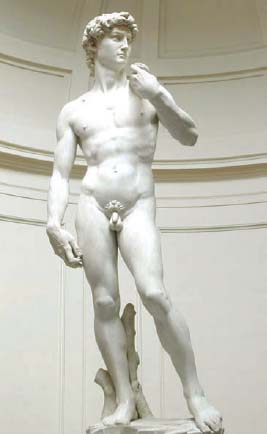The Early Modern World, C. 1300–1600High Renaissance in Italy |
How can you recognize “a Michelangelo”? |
The work of Michelangelo has a very particular style, in both painting and sculpture. Michelangelo’s David is a good example of this style, which emphasizes physical idealism of the human form, especially the male form. The David is monumental in size at seventeen feet tall and was cut from an eighteen-foot block of white marble. David is shown at the peak of his youth; he is strong, athletic, nude, and flexing his muscles as he prepares for battle with his enemy, Goliath. His hands and feet are both oversized and highly realistic, the veins and ligaments of the hands are clearly visible even from afar. One knee is slightly bent and the hips tilt to one side—the traditional contrapposto pose—which adds a sense of life and realism to the sculpture. Many of Michelangelo’s other works also emphasize physical perfection and include large figures with broad shoulders, flexed muscles, and serious faces.

Michelangelo’s famous David (1501–1504) is quite different than Donatello’s youthful bronze: this larger-than-life marble sculpture idealizes the human form. David stands, confidently awaiting his rival—the giant Goliath—with flexed muscles and weapon in hand.
